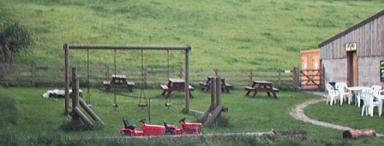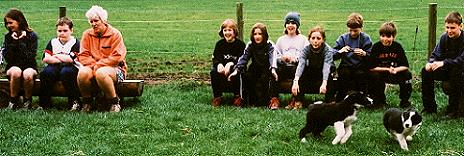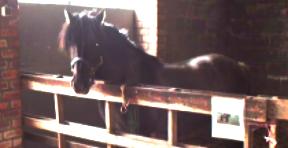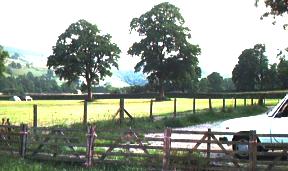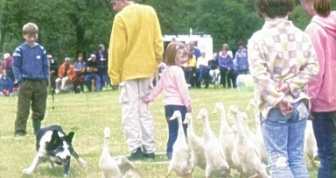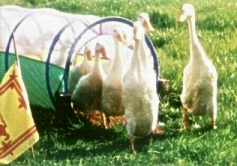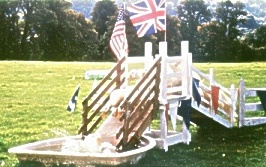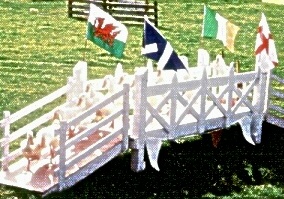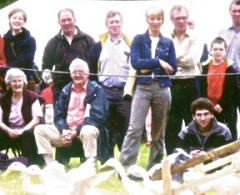You are here >>>> Foot and Mouth >>>> Farm Diversification |
|||||
Border Collie Rescue - On Line - Farm Diversification |
|||||
 |
|||||
 |
Farm diversification - a way forward. A prefix on the subject of farm diversification - By Mike Cooke. |
 |
|||
| Hazel Brow farm - Low Row - Swaledale | |||||
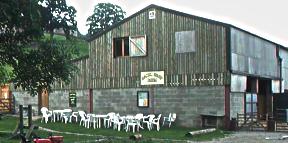 The Visitors Centre |
Hazel Brow farm is located in the heart of Swaledale in the village of Low Row. It is a 200 acre hill farm following the traditional farming layout in the Dales of having fields and pockets of land spread over several miles of the Dale, making the logistics of keeping the whole farm running as a unit more difficult than normal. The type of land available for farming varies greatly in the Yorkshire Dales. Hazel Brow typifies this, having flat meadowland bordering the river Swale, useful for the production of hay, with steeply sloping pastures on the hillsides and wilder moorland grazing on the tops, along with 'gates' on the open moors where they have the rights to free range livestock in the warmer seasons. Like many hill farms the principal stock kept here are sheep and cows, the latter for milk, rather than beef production. |
||||
Foot and Mouth Disease, thanks to the vigilance of the local community, never hit Swaledale, although the drastic restrictions on trade and the movement of livestock had a profound effect on the viability of the farming community, but Hazel Brow had commenced diversification before the onslaught of Foot and Mouth. This is a family run farm under the control and supervision of the Calvert family, with brothers David and Raymond looking after the day to day activities of the farm, while David's wife Cathy looks after the visitors centre, which was their first experiment into ways of diversifying their activities and improving their income. |
Children's Play and Picnic Area |
||||
This has proved to be very successful, both as a tourist attraction and educational facility with casual visitors always sure of a warm welcome and school groups given insights into the methods of both traditional and contemporary farming techniques. Outbuildings and barns on the valley bottom under Low Row have been converted to enable visitors to take a tour, the route of which has been cleverly devised to take them through a series of areas dedicated to different activities and housing a variety of farm animals and equipment. All these areas are illustrated with boards and notices offering information on the occupants and hardware. The venture is family orientated with a separate children's play area complete with climbing frames and picnic tables, a 'discovery room' with lots of information, audio/video display and farming memorabilia, an easy to follow riverside walk with information provided at points en-route and a 'Woolly' play area with a display of innovative British wool products. The addition of a gravelled car park, Farm Shop and Tea Room provides visitors with everything they want for a full day out. The centre is accessible to wheelchairs users with ramps, wide doors and disabled toilet facilities. |
|||||
Hazel Brow is open between April and September with different demonstrations each day of the week and seasonal activities as appropriate. Cathy works hard thinking of new ideas and innovations to keep the centre fresh and to provide something new for the many visitors that attend regularly. |
|||||
A chance to meet the Puppies |
A further distinction has added extra interest to the farm and added value for the consumers of their produce. A decision was made to go 'Organic' and the farm was in conversion for two years in order to win the necessary approval and now has the Soil Associations organic accreditation. This was not a simple process and such awards are not given lightly. There is no use of chemical fertilisers or soil treatments, stock has to be moved under a strict regime to break the cycle of internal parasites and eliminate the need for chemical wormers. Ailments within the herds and flocks are treated with natural remedies and homeopathic medication as much as practicable. A lot of thought and extra work needs to go into the care and raising of the livestock with no artificial growth accelerators to 'fatten up' stock, as is common in modern intensive farming. High quality feeds and extra attention are needed. |
||||
Organic milk from the farm's dairy herd is now a very successful product with some going to the Swaledale Cheese Company in Richmond to make organic cheese. Swaledale lamb from the farm is sold direct to selected local butchers and direct to the public in fresh or frozen form, cutting out middlemen and increasing profitability and viability. This conversion has been in the making for many years with a barrage of red tape, forms, paperwork and approval from various officials and organisations, but the Calverts have stuck to their guns and taken on this massive amount of work and got the job done. |
Smokey - the Farm Pony, who gives rides to young children |
||||
Car park and Valley View |
Many would have given up, as many do and we would have lost another British farm. Instead we have gained a farm that is showing the way forward, producing healthy organic food. A farm we can visit and see for ourselves how it's done. To visit the Hazel Brow Farm Website for up to date details of opening times, demonstrations and admission charges - |
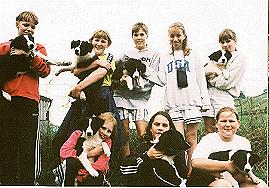
Close Encounters |
|||
E.mail them on - info@hazelbrow.co.uk |
|||||
Write to - Hazel Brow Farm, Low Row, Richmond, North Yorkshire, DL11 6NE or Telephone +44 (0)1748 886224 |
|||||
|
|
|||||
|
Hill Of Camstraddan Farm is situated on the western banks of Loch Lomond in Argyll Scotland, close to the village of Luss. The farm is run by Mark Wylie and is a typical Scottish hill farm running some 500 sheep on the fells with some lower pasture land in bye. When economic pressure on sheep farming started to make the future look gloomy, Mark decided to fight back to retain his traditional lifestyle in the countryside he loved and looked around for a form of diversification that would make the best of his environment and location. | ||||
Being a dedicated sheepdog trainer, successful trialist and shepherd, Mark decided that he would look to his beloved and devoted Border Collies to increase the income of his farm by displaying their skills to the public in the form of working dog demonstrations. The location of his home, near the village of Luss on the shores of Loch Lomond meant that he was sure of a seasonal influx of tourists either passing or visiting one of his countries most famous Lochs, reputed to be the deepest in Scotland, surrounded by legends and folklore and celebrated in song. This seemed a logical and environmentally friendly way to combine his passion and his gift of the gab and put on a show that would appeal to people with an interest in the countryside and rural crafts. |
|
||||
|
The first shows were held in one of his fields adjacent to the village of Luss and was an instant hit with tourists and locals alike, appealing equally to young and old. Strangely enough it was the the restrictions of Foot and Mouth that really made the demonstrations kick off. When the crisis hit, although the region was not infected, MAFF put restrictions on the movement of sheep all over the UK. Mark was unable to move sheep to the field where the demonstrations were held and was left with a dilemma which he solved by purchasing a flock of 19 Indian Runner Ducks. These birds are real characters. They do not fly, but do flock together like sheep and have an advantage in that they are natural entertainers in their own right. They are fearless, daring and incredibly comical in their interaction with the dogs. | ||||
There were no restrictions on the movement of ducks, and what's more, the risk of a member of the public inadvertently bringing the disease into his flock was eliminated because the sheep never came into contact with the visitors or the demonstration field, so Mark was able to take suitable disinfection precautions and continue with the events. Using a team of four dogs, Trim, Peg, Hope and Spot, Mark was able to give working sheepdog displays throughout the crisis, which helped him continue to grow where others were floundering. The following year, word had travelled and Mark, his dogs and his ducks were invited to attend and demonstrate at various agricultural shows, galas, festivals - and even at weddings - all over Scotland, the North of England and Ireland. |
|
||||
It seemed that the gamble had paid off. Mark had got his show very professionally organised. Using a combination of commands, his dogs will navigate the ducks around a course which includes a long, dark tunnel and some appropriately named obstacles like "The Golden Yoke Bridge", the "Bridge over the River Quack" (a rope affair) and the "Ben Lomond Chute", a slide into a pool. During this display Mark gives an educational and informative commentary with a fair bit of humour built in. This is the fun side of his life - it brings extra income and guarantees a future, but Mark is a serious shepherd. His heart is in the land and his skills are those of a sheep and dog man in the best Scottish tradition. Diversification is a means of survival. A way of holding on to what is precious. A way of preserving something for future generations. Behind his humorous commentary is a message about the skills of his dogs and the value of the Border Collie to the working farmer and shepherd. Mark firmly believes that the only reason stock farming has survived in much of Scotland is because the men who work the hills and glens have Border Collies to help them. Without these dogs the work could not be done and we would be looking at a different landscape without shepherds and sheep to aid in its management. |
|||||
Mark Wylie has utilised a variety of his talents to keep his farm viable. It's a good example of how you can diversify if you use your imagination. Daily demonstrations now form a major part of his summer routine. Sunday to Friday on the farm and Saturdays away at a show or event. That, with tupping and lambing and over-wintering his stock, its a pretty full year. Not much time left for trialing - another of Marks passions. But you wouldn't be a shepherd or a farmer if you were scared of hard work and unsociable hours! |
|||||
E.mail him on - hillfarmluss@hotmail.com |
|||||
Write to - Mark Wylie. Hill of Camstraddan farm. Luss, Loch Lomond, Argyll, Scotland. G83 8NX or Telephone +44 (0)1436 860262
If you are interested in adopting a Border Collie from us, |
|||||
| TOP | |||||
| You are here >>>> Foot and Mouth >>>> Farm Diversification | |||||
| Copyright - Border Collie Rescue - 3037504 | |||||



